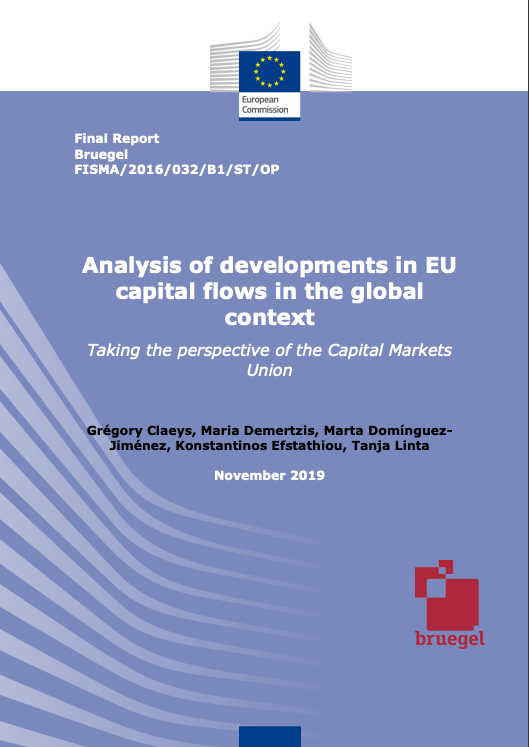External Publication
Analysis of developments in EU capital flows in the global context
This report presents an overview of the recent trends of capital flows, focused especially on the past year. It provides a detailed analysis at the global level and at the European Union level.
This material was originally published in a study commissioned by the European Commission’s Directorate-General for Financial Stability, Financial Services and Capital Markets Union. The opinions expressed in this document are the sole responsibility of the authors and do not necessarily represent the official position of the European Commission. The study is available on the European Commission’s webpage.
©European Union, 2019
From a global perspective, the first key takeaway from the report is that 2018 has seen the persistence of the current account imbalances of developed economies, consistent with a medium-term redistribution of global surpluses and deficits away from emerging economies that has been taking place since 2014. While both the surpluses and the deficits of emerging economies are diminishing, a shift in the distribution of global surpluses away from China and towards oil exporters has taken place throughout 2018, mainly as a result of the increase in the price of oil over that same period. Meanwhile, the current account imbalances of developed economies continue to be polarised between the surpluses of the euro area and Japan and the deficits of the US, the UK, and a group of advanced deficit economies.Digging deeper into the EU’s situation, the main development in 2018 has been the fall in the EU’s financial account surplus, driven by a relatively broad-based fall in its member states’ financial accounts. That said, the EU remains the most prominent net exporter of capital, with a financial account surplus of 2% vis-à-vis the rest of the world. An important driver of the fall was the decline in the German financial account surplus, matched by a by a rise of domestic household and corporate investment in the current account. Germany’s long-standing surplus has been a key contributor to the EU’s overall position, in contrast to the UK and France’s continued deficits.
Secondly, and partially as a result of this polarisation, the divergence in net international investment positions between the two most important net debtor economies has continued in 2018. The US has seen a further deterioration of its NIIP throughout the year while the euro area continues to converge towards a balanced position. NIIP imbalances are mainly the result of the trade imbalances of the last decade. The trends concerning trade balances have persisted in 2018: creditors generally continued to run surpluses and debtors to run deficits. At the same time, valuation effects on the stock of existing foreign assets and liabilities have contributed in the other direction, preventing a stronger divergence in NIIPs. The notable exception is the US: a stronger dollar throughout 2018 combined with persistent trade deficits have supported the deterioration in the US net foreign asset position, absorbing improvements in the NIIPs of the rest of the world.
Thirdly, a common factor behind recent global developments in capital flows has been the monetary divergence among advanced economies, and 2018 saw a partial shift between the first and the second half of that year. In the first half of 2018, the size of net portfolio debt outflows fell in comparison to previous years. This was motivated by the expectation of better economic prospects for the euro area and an eventual monetary tightening by the ECB which had increased yields somewhat. At the same time, the actual interest rate differential between the US and the euro area pushed the cost of hedging dollar investments higher. As a result, the hedged yield of (risk-free) dollar investments became less appealing than the euro equivalent over time. Analysis of developments in EU capital flows in the global context November 2019 10 Nonetheless, economic optimism about the euro area was short-lived. Already by the second-half of 2018, euro area growth was expected to disappoint expectations for that year, as well as underperform forecasts for 2019. Although growth forecasts for 2019 were also revised downwards for the US, the expected interest rate differential between the US and the euro area widened again as markets ruled out gradual interest rate hikes in the latter and actually began to price a cut in 2019 and other measures such as the return of net asset purchases, which actually took place in September 2019. As a result, net portfolio debt outflows from the euro area could intensify in the second half of 2019. After all, the interest rate differential between the US and the euro area, given the difference in the speed of the economic recovery between the two regions from 2013-14 and as a result of Fed rate hikes and expectations thereof, has been the most important driver of the net portfolio outflow from the euro area in recent years. At the same time, the strengthening of the US dollar throughout 2018 had an important effect on global trends and followed an appreciating euro the previous year. Partially as a result of this, emerging market currencies suffered severe depreciations in the course of the year, but their value seems to have stabilised in the first half of 2019. This is partially driven by the weakening global outlook of the past several months which has altered expectations about the monetary policy of both the Federal Reserve (Fed) and of the ECB.
Finally, the evolution of global FDI flows this year has been particularly important. This report provides several key takeaways in this regard. From a global standpoint, the main development in net FDI flows in 2018 has been the increase in net inflows into the US throughout the year, partly related to repatriation of previous earnings from US multinationals after the enactment of the Tax Cuts and Jobs Act (TCJA). On the other side of the Atlantic, the EU has been recording stronger net FDI outflows in the past year. This represents a partial shift from 2016-17 when FDI flows were close to balance (after a reduction of outflow in the aftermath of the crisis). Germany, France and the Netherlands have been the main source of FDI, while the UK generally exhibits net inflows. British fluctuations in the post-crisis period (including the recent fall in inflows) have had a significant impact on the overall EU balance.
That said, the evolution of gross flows throughout 2018, mainly driven by FDI, has been more significant, both at the Global and at the EU level, and warranted deeper analysis. In recent quarters, the reduction in direct investment flows which started in 2015 accelerated substantially. This had been compensated until 2017 by an increase in portfolio investment and other investment, when both also started to decrease, causing a reduction in total flows. The drop was largest in the US and the euro area, where it was largely driven by large declines in Luxembourg, the Netherlands and, to a lesser extent, Hungary. These can be attributed to the recent decrease in flows to and from special. purpose entities (SPEs). The slowdown on the liability side follows a similar pattern, and it is also mainly driven by the euro area. These developments are mainly driven by the slowdown of flows from non-EU Ultimate Investing Countries (UICs) to non-EU Ultimate Host Countries (UHCs) that pass through a set of specific EU countries that have been heavily used as Analysis of developments in EU capital flows in the global context November 2019 11 conduits of FDI, mostly those with high concentration of SPEs. On the contrary, ‘genuine’ FDI flows in and out of the EU are much more robust. Indeed, there is evidence that the decrease in gross flows in the EU is concentrated among SPEs in Luxembourg and the Netherlands, while the evolution of flows in most of the remaining EU countries that do not host SPE activities is much more stable. In addition, EU countries with a high presence of SPEs or entities that serve as FDI conduits have large FDI asset and liability positions with extra-EU countries and among themselves (the Netherlands and Luxembourg are in the global top three of largest sources and destinations of direct investment, along with the US). The question of which non-EU countries are behind the slowdown is more difficult to answer as we do not observe bilateral flows. The US is the most plausible candidate to be the ultimate investing country behind the slowdown, given that a decrease in its flow of asset acquisitions is not matched by liabilities. With regards the ultimate host country, possible explanations include the fall seen in the UK because of the uncertainty surrounding Brexit, China and other Asian countries because of the global trade and geopolitical tensions, the US itself, mainly because of the changes in its legislation, and, more plausibly, a combination of these three explanations. Considering the flexibility of SPE structures used by MNEs and the tax, regulatory and confidentiality benefits some global financial centres provide, it can be expected that even small changes in legislation can shift investment flows’ pattern. A good example of a legislation change that might have contributed to the global drop in FDI is the 2017 US Tax Cuts and Jobs Act (TCJA).













